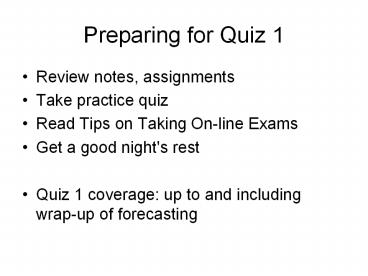Preparing for Quiz 1 - PowerPoint PPT Presentation
Title:
Preparing for Quiz 1
Description:
The Bard Outside theatre group puts on plays by Shakespeare 20 times every ... Bard Outside's accountant says they've been earning an average of $100 per night ... – PowerPoint PPT presentation
Number of Views:22
Avg rating:3.0/5.0
Title: Preparing for Quiz 1
1
Preparing for Quiz 1
- Review notes, assignments
- Take practice quiz
- Read Tips on Taking On-line Exams
- Get a good night's rest
- Quiz 1 coverage up to and including wrap-up of
forecasting
2
Quiz Schedule
Lab section Enter lab Quiz begins Quiz ends
8 am 755 800 840
9 am 855 900 940
11 am 1055 1100 1140
12 pm 1155 1200 1240
All lab sections treated the same
3
When you come to the lab
- Find your assigned computer
- Logon to the course web
- You may copy materials to the desktop before the
quiz starts - From USB key, CD, or email
- You may not use a USB key, CD, email, etc. during
the quiz - Listen carefully to instructions
- Have OneCard ready.
4
Reminders
- Quiz 3 is now on 30 March
- HW 3 due Wed
- Quiz Review Session, Thu 5 630 pm, BUS B-2428
- Optional
- QA session, no new material
5
MGTSC 352
- Lecture 7 Monte Carlo Simulation
- Bard Outside example
6
Bard Outside
- The Bard Outside theatre group puts on plays by
Shakespeare 20 times every summer in a 200-seat
outdoor theatre. - Data
- Attendance and weather (rain / no rain) for last
five seasons (5 x 20 100 shows) - Revenue 10 per customer
- Cost 1,600 per show
- Question how much would profit increase if the
number of seats were increased?
7
Profit
- Profit Revenue Expenses
- Revenue
- Expenses
- What do we need to find out?
- How can we do this?
8
Data Analysis
- Whats the probability of rain?
- What is the mean and standard deviation of demand
when it rains? - How about when it doesnt rain?
- How can we simulate demand?
- To Excel
9
Simulating Profit per show
- Simulate weather
- Simulate demand
- Make sure 0 demand capacity
- Calculate revenue
- Subtract cost
- Replicate!
- Remember freeze tables of simulation results
10
Simulating a value from a Normal
DistributionBreaking the formula down
- ROUND(NORMINV(RAND(),mean,stdev),0)
- Step 1 generate random numberRAND()
- Step 2 convert random number to normal
distributionNORMINV(RAND(),mean,stdev) - Step 3 round to whole number ROUND(NORMINV(RAND(
),mean,stdev),0)
11
Converting random number to a normal distribution
Simulated Value 990.3
12
Final results
13
Comparing Different Capacities
- Want to compare 200 seats and 210 seats
- Approach 1
- Simulate demand for 100 days
- Compute profit for each simulated day, assuming
200 seats - Simulate demand for another 100 days
- Compute profit for each simulated day, assuming
210 seats - Compare average profits
- Approach 2
- Simulate demand for 100 days
- Compute profit for each simulated day, assuming
200 seats - Compute profit for each simulated day, assuming
210 seats (reuse the 100 simulated demands) - Compare average profits
- Active learning which approach is better?
- 1 min., in pairs
- List as many pros and cons as you can
14
Pros and Cons
- Approach 1(simulate 2 ? 100)
- Approach 2(simulate 1 ? 100)
15
Bard Outside Example A Newsvendor Problem
- Bard Outside
- Decision of seats
- Uncertain future demand
- Demand gt of seats ? lost revenue
- Demand lt of seats ? empty seats
- A newsvendor
- Decision of newspapers to get
- Uncertain future demand
- Demand gt of papers ? lost revenue
- Demand lt of papers ? disposal costs
16
Active Learning
- In pairs, 1 min.
- Think of three other examples of newsvendor
problems - Examples
17
Bard Outside Revisited
- We estimated the average profit per show with 200
seats to be about 11 per night - Bard Outsides accountant says theyve been
earning an average of 100 per night - Whats wrong?
18
Another look at the No Rain Attendance
Distribution
Attendance (up to 199)
200 or more 51 of the time
19
What we did Fit a Normal Distribution with Mean
176, Stdev 39
Attendance of 200 or more 51 Demand of 200 or
more 27
Demand
Attendance
Can we do better?
20
How about this Normal Distribution with Mean
200, Stdev 50
Attendance of 200 or more 51 Demand of 200 or
more 50
Demand
Attendance
The attendance distribution is a censored
version of the demand distribution. We need to
uncensor it before using it to simulate.
21
How Much Difference Does this Make?
Avg. profit (/show) 200 seats 210 seats 220 seats Extra profit per seat
Take 1 11 24 33 1.10
Take 2 113 146 173 3.00































